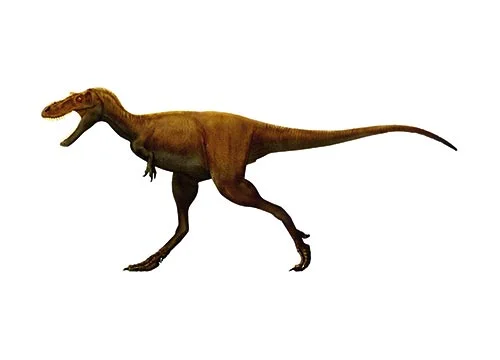Gorgosaurus (Fierce lizard)

Gor-go-sore-us
Lawrence Lambe - 1914
Carnivore
Estimated 9 meters long
Large Theropod
G. libratus (type)
Canada, Alberta. Possibly the US state of Montana
Late Cretaceous, 76-68 million years ago
Gorgosaurus Facts
Gorgosaurus is a genus of carnivorous theropod dinosaur that lived during the Late Cretaceous period, approximately 76 to 68 million years ago. Its name means “fierce lizard,” and it is part of the family Tyrannosauridae, which also includes the famous Tyrannosaurus rex. Gorgosaurus fossils have been found in what is now western North America, including the United States and Canada.
Gorgosaurus was a large, bipedal dinosaur that measured up to 9 meters (30 feet) in length and weighed up to 2.5 metric tons. It had a massive skull, with powerful jaws and sharp, serrated teeth up to 18 centimeters (7 inches) in length. Its arms were relatively short and had two-fingered hands, and its hind limbs were long and powerful, allowing it to run at high speeds.
One of the most notable features of Gorgosaurus is its cranial ornamentation, which includes a series of bony ridges and crests on the top and sides of its skull. These structures are believed to have played a role in species recognition, communication, or display.
Like other tyrannosaurids, Gorgosaurus was a top predator in its ecosystem and likely preyed on large herbivorous dinosaurs such as ceratopsians and hadrosaurs. Its powerful jaws and sharp teeth would have made quick work of its prey, and its size and strength likely allowed it to dominate other predators in the area.
Gorgosaurus is an important dinosaur for paleontologists because it helps to fill in gaps in our understanding of the evolution and diversity of tyrannosaurid dinosaurs during the Late Cretaceous period. Its anatomical features, such as its cranial ornamentation and dental characteristics, provide valuable insights into the ways that these dinosaurs adapted to different ecological niches and pressures.
In conclusion, Gorgosaurus was a fierce and powerful predator that roamed North America during the Late Cretaceous period. Its massive skull, sharp teeth, and other anatomical features made it a formidable hunter, and its place in the ecological context of its time highlights the important role that top predators played in shaping ancient ecosystems. As more fossils are discovered and studied, we are likely to learn even more about this fascinating and important dinosaur and its place in the evolutionary history of tyrannosaurid dinosaurs.



